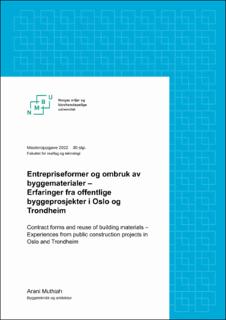| dc.contributor.advisor | Houck, Leif Daniel | |
| dc.contributor.author | Muthiah, Arani | |
| dc.coverage.spatial | Norway | en_US |
| dc.date.accessioned | 2022-10-18T11:01:14Z | |
| dc.date.available | 2022-10-18T11:01:14Z | |
| dc.date.issued | 2022 | |
| dc.identifier.uri | https://hdl.handle.net/11250/3026632 | |
| dc.description.abstract | De siste årene har interessen for ombruk i byggeprosjekter økt betraktelig. I Norge er 80% av utslippene fra bygg- og anleggssektoren knyttet til byggematerialer og byggearbeider (Asplan Viak, 2019). Ved å satse på sirkulær omstilling vil utslippene reduseres med 50% (Asplan Viak, 2019). Ved ombruk av byggematerialer blir råvare materialer ikke benyttet, og på den måten kan man unngå store mengder klimagassutslipp under produksjon. Materialer som ombrukes har 90-99% mindre utslipp en nyproduserte ressurser (Byggalliansen, u.å.).
Hensikten med oppgaven er å avdekke hvordan valgt entrepriseform påvirker ombruk av byggematerialer i byggeprosjekter. Oppgaven studerer også de kontraktuelle mulighetene og utfordringene med ombruk av byggematerialer. I tillegg er det en rekke risikoer som følger med ombruksprosjekter fra både byggherre- og entreprenørsiden, og denne oppgaven forsøker å besvare hvordan disse risikoene håndteres av partene.
For å belyse forskningsspørsmålene er det gjennomført en kvalitativ forskning bestående av en litteraturstudie og casestudie. Litteraturstudiet hadde som formål å kartlegge erfaringer og kunnskap som eksisterer i byggenæringen om det valgte temaet og forskningsområdet. Informasjonskildene i casestudien var dokumentstudier og semistrukturerte intervjuer med seks informanter. Casestudien bestod av to offentlige pilotprosjekter som er pågående, Oslo Storbylegevakt i Oslo og Nidarvollprosjektet i Trondheim.
Studien belyste at byggherre selv kan påvirke i hvor stor grad de ønsker å ha kontroll over ombruksprosessen ved valg av entrepriseform. Utførelsesentrepriser tillater å avdekke hvilke materialer som er tilgjengelig for ombruk underveis i prosjektet, ettersom det er byggherre som koordinerer prosjektering og utførelse. Med totalentrepriser må ombruksmaterialene være avklart på forhånd, hvis en vil få til en god ombruksprosess. Samspillsentreprise viser seg å være hensiktsmessig i ombruksprosjekter ettersom aktørene kan komme med felles målsetninger til ombruk. OPS er en driver for innovasjon og ombruk ettersom samspillet mellom aktørene skaper merverdi. Mulighetene med ombruk i kontrakten er tydelige krav, samspillskontrakter, tildelingskriterier og økonomiske incitament ordninger. Utfordringene med kontrakten er utydelige og manglende krav, tilgjengelighet i markedet, mellomlagring av materialer, prioriteringsrekkefølgen og entreprenørens påvirkningskraft. I de undersøkte casene er det kun byggherre som påtar seg risikoen med ombruk, mens entreprenør ikke påtar seg risiko utover de de vanlig gjør i andre byggeprosjekter. | en_US |
| dc.description.abstract | In recent years, interest in reusing building materials has increased significantly. In Norway, 80% of emissions from the construction sector are related to building materials and construction work (Asplan Viak, 2019). By investing in circular conversion, emissions will be reduced by 50% (Asplan Viak, 2019). When reusing building materials, raw materials are not used. This has a positive effect as large amounts of greenhouse gas emissions can be avoided during production. Materials that are reused have 90-99% fewer emissions than newly produced resources (Byggalliansen, u.å.).
The purpose of this thesis is to uncover how the chosen form of contract affects the reuse of building materials in construction projects. Furthermore, the thesis studies the contractual opportunities and challenges that exist in connection with the reuse of building materials. In addition, several risks come with reuse projects from both the client and contractor side, and this task attempts to answer how these risks are handled by the parties.
To shed light on the research questions, qualitative research has been carried out consisting of a literature study and a case study. The purpose of the literature study was to map experiences and knowledge that exist in the construction industry about the chosen topic and research area. The sources of information in the case study were document studies and semi-structured interviews with six interview objects. The case study consisted of two ongoing public projects, metropolitan emergency room in Oslo and the Nidarvollproject in Trondheim.
The study highlighted that the client themselves can influence the extent to which they want to have control over the reuse process when choosing the form of contract. Execution contracts allow us to uncover which materials are available for reuse during the project, as it is the client who coordinates the design and execution. With turnkey contracts, the reuse materials must be clarified in advance, if a good reuse process is to take place. Interaction contracts prove to be appropriate in re-use projects as the parties can come to common terms for re-use. PPP is a driver for innovation and reuse as the interaction between the players creates added value. The possibilities for reuse in the contract are clear requirements, interaction contracts, award criteria and financial incentive schemes. The challenges with the contract are unclear and missing requirements, availability in the market, intermediate storage of materials, the order of prioritization and the contractor's influence. In the investigated cases, only the client assumes the risk of re-use, while the contractor does not assume risk beyond what they usually do in other construction projects. | en_US |
| dc.language.iso | nob | en_US |
| dc.publisher | Norwegian University of Life Sciences, Ås | en_US |
| dc.rights | Attribution-NonCommercial-NoDerivatives 4.0 Internasjonal | * |
| dc.rights.uri | http://creativecommons.org/licenses/by-nc-nd/4.0/deed.no | * |
| dc.subject | Gjenbruk | en_US |
| dc.subject | Byggematerialer | en_US |
| dc.title | Entrepriseformer og ombruk av byggematerialer : erfaringer fra offentlige byggeprosjekter i Oslo og Trondheim | en_US |
| dc.title.alternative | Contract forms and reuse of building materials : experiences from public construction projects in Oslo and Trondheim | en_US |
| dc.type | Master thesis | en_US |
| dc.description.localcode | M-BA | en_US |

